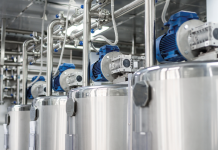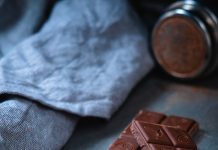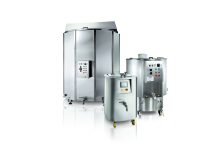A natural lacquer for metal food cans, obtained from industrial processing of tomato skins: this is the core of two Biocopac and Biocopac-plus projects. The name derives from the acronym of BIO-based COating for PACkaging; both projects – the second being the prosecution of the first – have been funded by two European action projects: FP7 (addressing research and innovation) and Life (supporting environmental, nature conservation and climate action projects).
This research complies with EU policies, especially with the principles of environmental sustainability and Circular Economy. “Circular Economy” is a new approach promoted by the EU among member states for preserving the value added in products for as long as possible. The aim is to delay as long as possible the elimination from the production cycle through tools such as recovery, re-use, recycling. To this end, the researchers involved in both Biocopac projects developed a cutin-based lacquer (a natural biopolymer extracted from peels and seeds of tomato by-products) in order to recycle part of the 200 thousand tons of solid waste (mainly skins and pips) that Europe’s tomato industry produces every year. This lacquer should replace some of the chemical compounds currently used in the varnish used for lining food cans. This solution, emphasise the researchers, provides a significant contribution to the sustainability of the European industry, and ensures important advantages to both, consumers and industry. The natural lacquer, in fact, will meet the demand for safer, sustainable and recyclable packaging and will deliver the packaging industry effective tools to re-affirm its image, weakened by the doubts on their products’ safety. In fact, over the last years, the lacquer system of metal surfaces, involving the possible migration of potentially hazardous contaminants from the lacquer to the food, has been object of frequent alert notifications. The study also provides an important contribution to the research on packaging bio-materials, especially those for food packaging. The first Biocopac project – now completed – mainly addressed the validation of the new substance, and was divided in various packages involving: characterization of tomato skins to assess their chemical-physical properties; optimization of the cutin extraction method in laboratory and on a pilot plant; development of the most effective bio-resin production method (one water-based and one solvent-based); application of the natural lacquer on different substrates (metal sheet, TFS – Tin Free Steel- and aluminium); assessment of its suitability for industrial production of new metal cans; and assessment of the performance of the new lacquer on full food cans. The project involved also the analysis of the environmental impact resulting from the production of cans painted with this bio-lacquer, performed through a Life Cycle Assessment analysis, i.e. an international standard that can help determine environmental and energy burdens associated to a process or activity. The project consortium co-ordinated by SSICA (Experimental Station for the Food preserving Industry) comprises four leading research centres, four SMEs and three large enterprises from six different EU countries (Czech Republic, France, Italy, Greece, Liechtenstein and Spain). Biocopac’s concept, in fact, is based on an old patent developed by SSICA in the 1940s. We asked Angela Montanari, responsible for SSICA’s Packaging Department and project coordinator, to describe the results and prospects of this research.

Which are the project general outcomes?
The aim of the first Biocopac project was to develop a full natural lacquer possessing the same chemical-physical properties of conventional lacquers and usable in modern industrial packaging plants. In fact, we succeeded in producing a lacquer with these properties, although only at laboratory level in this first phase (industrial large-scale implementation will be the aim of the new Biocopac-plus project). We optimized the extraction method of cutin and assessed its repeatability in different conditions (the extraction method is repeatable irrespective of the geographical origin and of the type of skins Ed.). Furthermore, we defined the chemical-physical parameters of the new lacquers (chemical resistance, grip, etc.) and tested their suitability for food contact, according to Italian and European legislation. To test its industrial functionality, the lacquer was applied (in laboratory) on metal sheet, Tin-Free Steel, and aluminium, and these substrates were then processed on the production lines of three project partners active in the food packaging industry (Rodolfi Mansueto in Italy, Conservas Martinete in Spain, and Saupiquet in France). Here metal cans in two or three parts containing tuna in oil and tomato-based products were analysed. Two months have elapsed since the packaging, and now we are evaluating the outcomes (the minimum duration of this activity generally is of at least 6 months at 37°C). The outcomes of this preliminary test, however, are encouraging, especially taking into account that the application of the lacquer on materials was performed in a laboratory (at the facility of the Italian project-partner Salchi) and not on industrial scale.
From the production point of view, do these procedures involve costly arrangements in terms of equipment and personnel training?
Natural lacquer should be produced by companies that are already producing chemical paints; presently used substances can be simply substituted with cutin. Even the cutin extraction plant is equivalent to those currently used for the extraction of monomers and basic compounds necessary for the production of chemical paints. In our project, this operation is carried out by a company that presently collects tomato skins and processes them for the production of biogas. We noticed, in fact, that waste skins can be used for the production of biogas with the same performance.
As regards the economic aspects, is cutin extraction an expensive method?
In the first project we did not address this particular point. Our intent was primarily one of gaining a lacquer offering the same chemical performances and costs of currently used substances. For the moment we tested all issues concerning the validity and suitability of the new lacquer. The feasibility of its industrial production will be the object of the Life project, which just started.
Did you have any problems with the shelf-life caused by the use of an organic component such as cutin?
Working in laboratory, on small quantities, we did not have problems of this kind, but we are dealing with this issue in view of the industrial production. The procedure is presently in the optimisation phase, with the ultimate goal of drying off the lacquer as far as possible, in order to prevent microbial development.
Is this project sustainable?
The LCA analysis has shown lower CO2 emissions compared to standard lacquers. We expected this result, but were surprised by the high reduction of emissions: even in laboratory test, not optimised from the point of view of energy consumptions, the calculated savings would be of approx. 130mg per can, a considerable amount.
Do you think that the same procedure can be used to process other industrial food by-products?
Cutin in fact could be extracted even from other substances; an alternative that has been explored already, consists in extracting compounds that are similar to cutin from a variety of food by-products. Positive experiences in this direction have been made in Northern Europe, where suberin was extracted from potato peel.
Which are the lines of development you’ll follow in the future?
The new Biocopac plus project will address the construction of a semi-industrial production plant, with a capacity of approx. 100 kg of peels per hour. It will be followed by an industrial implementation in order to guarantee the production of adequate amounts of lacquer”. On the base of the results of the first Biocopac project, in fact, researchers have presented to the European Commission a new proposal which represents their ideal continuation. The aims of this research are the design and construction of a pilot plant for testing the applicability on a semi-industrial scale of cutin extraction processes and bio-lacquer production. The plant, located in Canneto dell’Oglio (MN), shall have a production capacity of 10-20% (approx. 100kg/h) of a potential industrial line, with a 10 – 15% yield target. The sugar and fiber content of cutin shall not exceed 0.5%. Biocopac plus will last for 3 years and will end in June 2017, with investments for more than two million Euro, half of which funded by the European Union.





